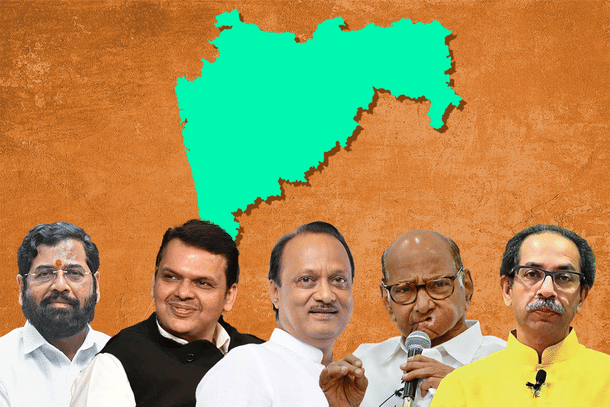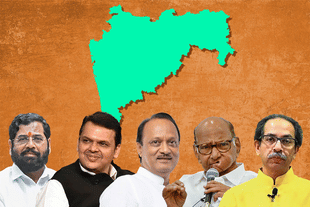Maharashtra
Maharashtra's $1 Trillion Target: Who Can Get It Done Sooner — Mahayuti Or MVA?
Shaunak Kulkarni
Nov 11, 2024, 06:23 PM | Updated Nov 12, 2024, 12:58 PM IST
Save & read from anywhere!
Bookmark stories for easy access on any device or the Swarajya app.


'Well begun is half done', it is said. This applies to Maharashtra.
As an economically prosperous state with Mumbai as its financial centre, a robust homegrown and foreign industrial base, and a strong network of co-operatives, it has always had an edge over other states.
Owing to a historically good start and the great thrust under Mahayuti rule in the last eight years, the state's GSDP (gross state domestic product) recently touched the $500-billion mark and is eying $1 trillion.
India is the fastest-growing large economy in the world, with eyes on the $5-trillion mark by the year 2027. Five states, namely Uttar Pradesh, Gujarat, Tamil Nadu, Karnataka, and Maharashtra, can grow and contribute about 50 per cent of the GDP (gross domestic product) of India to achieve this objective.
According to the Maharashtra Economic Survey for the year 2023-24, the state's nominal GSDP (at 2011-12 prices) is at Rs 4,044,251 lakh crore, contributing around 13 per cent of India's GDP.
The Maharashtra state government set up an Economic Advisory Council under Tata Sons Chairman N Chandrasekaran. The council presented a report to achieve the objective of $1 trillion GSDP by the year 2028.
With this background, it is worth exploring who can achieve this objective sooner, the Mahayuti or the Maha Vikas Aghadi (MVA), when the battleground for the assembly election 2024 is set and both political groups are ready to battle it out.
The Mahayuti government, led by the Bharatiya Janata Party (BJP), has always been associated with infrastructure development in the state.
The BJP-Shiv Sena Yuti had its first stint between 1995 and 1999. It set in motion significant projects and initiatives that accelerated the state's economy, such as the network of flyovers in the Mumbai metro region, the Mumbai-Pune Expressway, the Bandra-Worli Sea Link, and the Krishna Valley Development Corporation among others.
The political debacle of 1999 brought back the Indian National Congress (INC)-Nationalist Congress Party (NCP) government, which lasted until 2014. They delivered little more than cost and time overruns to projects initiated by the Yuti regime.
They led the state to stagnation, with industrial players and the services sector, predominantly information technology (IT), moving to other states.
They also led the state to power deficiency and a fall in ranking in foreign direct investment (FDI) inflow and per capita income.
Agriculture woes worsened with many unfortunate farmer suicides. Add to that law and order failures, like riots and terror attacks in Mumbai, Malegaon, and Pune.
In 2014, the BJP emerged as the single largest party in the state and formed the government with Devendra Fadnavis as chief minister. Fadnavis had a clear vision and his own ideas to get things done.
He started the Jalyukta Shivar initiative to rejuvenate groundwater, enhance farm productivity, and raise farmers' incomes. He himself led the initiative by visiting villages and work sites and set up a monitoring system with geotagging.
Jalyukta Shivar has rejuvenated groundwater levels in the drought-prone Marathwada-Western Vidarbha regions and added a disintegrated irrigation capacity of 26.52 TMC (thousand million cubic feet) in the state.
Fadnavis initiated the Mumbai Metro 3 (Aqua Line) and Mumbai Metro network under the Mumbai Metropolitan Region Development Authority (MMRDA), as well as Pune and Nagpur Metro projects. The Mahayuti government delivered the Pune Metro, Nagpur Metro, and three phases of the Mumbai Metro and is working on the remaining phases.
Maharashtra is a prosperous state with a disproportionate distribution of prosperity. Mumbai, Thane, Pune, Raigad, Nashik, and Nagpur districts contribute 54 per cent of GSDP, 11 other districts contribute 26 per cent, and 20 per cent comes from the rest.
To address this inequality and tap the potential of other regions, Fadnavis initiated and executed the greenfield Samruddhi Mahamarg Expressway, connecting Mumbai and Nagpur via Nashik, Chhatrapati Sambhajinagar, Washim, and Vardha.
It has opened new opportunities for the Aurangabad Industrial City (AURIC) under the Delhi-Mumbai Economic Corridor. The Samruddhi Mahamarg is to be connected to the Vadhavan Port, Jawaharlal Nehru Port (JNPT), and Navi Mumbai Airport.
The Mumbai-Pune Expressway catered to the rising demand of infrastructure in the rapidly developing economic centres of Mumbai and Pune, where the Samruddhi shall serve the long-term goal. It will redefine the industry-business canvas of Maharashtra with AURIC, the Amravati Textile Park, the Multi Modal International Cargo Hub and Airport at Nagpur (MIHAN), and Ambazari Garden Nagpur.
Fadnavis initiated and Mahayuti delivered the Atal Setu, connecting South Mumbai and Nhava Sheva, the Coastal Road.
He initiated the CM War Room for monitoring and executing these projects with the involvement of private consultants, young CM fellows, and young professionals.
The Mahayuti government under Chief Minister Eknath Shinde continued the work and is delivering mega projects like the Navi Mumbai Airport and Mumbai-Pune Missing Link projects among others.
The Maharashtra Institute for Transformation (MITRA), a think tank similar to NITI Aayog, is developing projects like Maharashtra Strengthening Institutional Capabilities in Districts for Enabling Growth (MahaSTRIDE) to diversify the industrial landscape and strengthen districts to enable growth.
The Mahayuti government has had a lot to offer other than infrastructure to the people of Maharashtra.
PM-Kisan and Namo Shetkari Mahasanman Nidhi have reduced the liquidity woes of the farmers in Maharashtra. The Mukhyamantri Baliraja Mofat Veej Yojana providing free electricity for irrigation pumps has significantly reduced the cost burden and shall definitely enhance productivity.
Maharashtra implements the integrated scheme of PM-Jan Arogya Yojana (Ayushman Bharat) and Mahatma Jyotiba Phule Arogya Yojana, extending Rs 5 lakh per annum per family as medical insurance cover for tertiary care.
The Mukhyamantri Majhi Ladki Bahin Yojana extends Rs 1,500 to registered women. The state government has already disbursed five instalments to the beneficiaries.
The state contributes around 13 per cent to India's GDP. It contributes the highest amounts of direct and indirect taxes. It can pull 67 per cent resources of its own for its expenditure with SGST, the Centre's contribution in the Union tax pull, and other resources.
Maharashtra contributes 15.5 per cent of the GVA of the manufacturing sector at the all-India level. It has regained its top position in FDI inflow, with Rs 5.7 lakh crore. With 18,634 recognised startups (December 2023), Maharashtra is the startup hub of India.
The Mahayuti has a comprehensive report card to present before the people of the state. What has the MVA to offer?
The MVA is associated with stays on development projects, cost and time overruns, and potential discontinuation of popular social schemes like Majhi Ladki Bahin.
It is not mere speculation. The MVA block did something similar after coming to power in 2019, disrespecting the people's mandate. The then-chief minister Uddhav Thackaray put a stay on Jalyukta Shivar, a flagship program that rejuvenated groundwater levels in drought-prone Marathwada and Western Vidarbha regions.
He stopped the Mumbai Metro 3 car shed at Aarey and went inordinately slow on the Samruddhi Mahamarg and bullet train projects among others. The delay on Aarey car shed cost Mumbai and the taxpayers a delay of more than three years in metro operations and a Rs 10,000-crore cost overrun.
Thackeray has vowed to put a stay on the Dharavi redevelopment project if elected to power. The Leader of Opposition in the Maharashtra assembly, Vijay Wadettiwar, has called for a review of the Majhi Ladki Bahin scheme if they come to power. Another INC leader has vowed to discontinue it if they come to power.
The Union government has supported Maharashtra with the announcement of new projects like the metro ring, multiple railway lines, and the mega infrastructure project of Vadhavan port.
Swatantryaveer Savarkar used to say Maharashtra must become the 'Khadga Hasta' of Bharat. Taking multiple factors such as vision, mission, and execution and the support of the Union government, Mahayuti can surely achieve the $1 trillion target sooner than MVA.
Maharashtra shall then continue to be the 'economic Khadga Hasta' of India, provided people give the clear mandate.
Shaunak Kulkarni is a digital marketing professional based in Pune. He writes on current events especially with a Maharashtra focus.





